
Grevillea excelsior, commonly known as flame grevillea or yellow flame grevillea, is a species of flowering plant in the family Proteaceae and is endemic to the south-west of Western Australia. It is an erect shrub or small tree with usually divided leaves with linear lobes, and clusters of orange flowers.
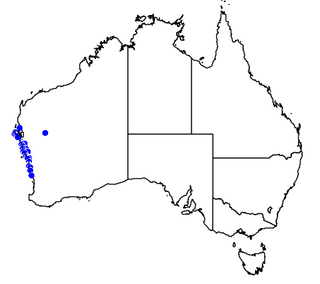
Commersonia borealis is a species of flowering plant in the family Malvaceae and is endemic to the southwest of Western Australia. It is a low growing, spreading shrub with egg-shaped to oblong leaves, and white, yellow and cream-coloured flowers.

Eremophila georgei is a flowering plant in the figwort family, Scrophulariaceae and is endemic to Western Australia. It is a common, widespread shrub in central areas of the state, often growing on rocky ridges and hillsides and has serrated leaves and mauve, purple or pink flowers.
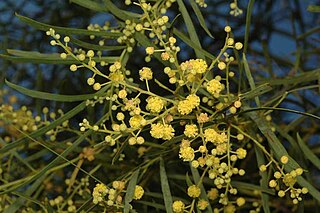
Acacia aestivalis is a species of flowering plant in the family Fabaceae and is endemic to the south-west of Western Australia. It is a bushy shrub or tree with linear to narrowly lance-shaped phyllodes, the narrower end towards the base, racemes of 5 to 11 spherical heads of golden-yellow flowers, and glabrous, papery to thinly leathery pods.
Verticordia muelleriana is a flowering plant in the myrtle family, Myrtaceae and is endemic to the south-west of Western Australia. It is an openly branched shrub with relatively large, egg-shaped to circular leaves and long spikes of deep maroon coloured flowers in spring and early summer.
Grevillea incurva is a species of flowering plant in the family Proteaceae and is endemic to inland south-western Western Australia. It is an erect shrub with linear adult leaves and clusters of creamy-yellow flowers.
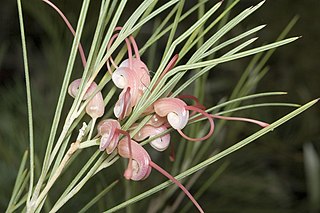
Grevillea oncogyne is a species of flowering plant in the family Proteaceae and is endemic to inland areas of Western Australia. It is an erect to spreading shrub with linear, sometimes lobed leaves, and clusters of red or pinkish red flowers.
Baeckea grandibracteata is a species of flowering plant in the family Myrtaceae and is endemic to central Western Australia. It is an erect to spreading shrub that typically grows to a height of 0.15 to 0.9 metres and blooms between September and December producing pink and white flowers. Found on undulating sand-plains in the eastern Wheatbelt region of Western Australia in the area around Yilgarn, it grows in sandy and sandy loam soils.

Conospermum eatoniae, commonly known as blue lace, is a species of flowering plant in the family Proteaceae and is endemic to the south-west of Western Australia. It is a spreading shrub with egg-shaped leaves only present on young plants, and panicles of glabrous blue, tube-shaped flowers with pale green bracteoles.

Leucopogon oliganthus is a species of flowering plant in the heath family Ericaceae and is endemic to the south-west of Western Australia. It is an erect, open shrub with white, tube-shaped flowers from August to November.

Androcalva luteiflora is a species of flowering plant in the family Malvaceae and is endemic to western Australia. It is an erect, sucker-forming shrub with egg-shaped leaves, the edges irregularly toothed, and clusters of 3 to 18 or more yellow flowers.
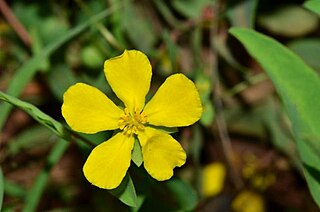
Hibbertia silvestris is a species of flowering plant in the family Dilleniaceae and is endemic to the south-west of Western Australia. It is a prostrate to more or less erect or spreading shrub with hairy young branchlets, elliptic to egg-shaped leaves with the narrower end towards the base and yellow flowers with seven to ten stamens on one side of two softly-hairy carpels.
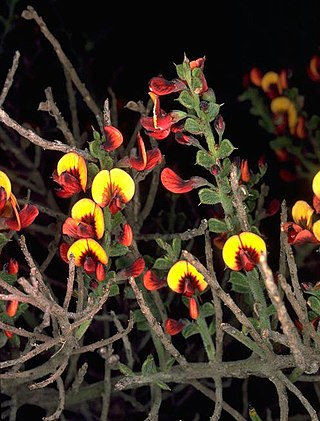
Daviesia dielsii, commonly known as Diels' daviesia, is a species of flowering plant in the family Fabaceae and is endemic to the south-west of Western Australia. It is on intricately-branched shrub with sharply-pointed, egg-shaped, vertically compressed phyllodes, and yellow and red flowers.
Lasiopetalum dielsii, is a species of flowering plant in the family Malvaceae and is endemic to the south-west of Western Australia. It is a spreading shrub with hairy stems, heart-shaped leaves and pink or white flowers.
Grevillea ceratocarpa is a species of flowering plant in the family Proteaceae and is endemic to inland areas of the south-west of Western Australia. It is an erect or spreading shrub with softly-hairy, narrowly elliptic or narrowly egg-shaped leaves with the narrower end towards the base, and creamy-white flowers.
Lasiopetalum microcardium is a species of flowering plant in the family Malvaceae and is endemic to the south-west of Western Australia. It is a low, spreading or straggling shrub with hairy stems, heart-shaped leaves and blue, purple or white flowers.

Leucopogon cinereus is a species of flowering plant in the heath family Ericaceae and is endemic to the south-west of Western Australia. It is an erect, compact shrub that typically grows to a height of 0.3–1 m and has white flowers from August to October. It was first formally described in 1904 by Ernst Georg Pritzel in Botanische Jahrbücher für Systematik, Pflanzengeschichte und Pflanzengeographie from specimens collected on rocky hills near Gillingarra. The specific epithet (cinereus) means "grey", referring to the colour of the young stems and leaves.
Pimelea gilgiana is a species of flowering plant in the family Thymelaeaceae and is endemic to near-coastal areas of north-western Western Australia. It is a shrub with narrowly egg-shaped leaves and head-like clusters of white or pinkish, dioecious flowers.
Thomasia dielsii is a species of flowering plant in the family Malvaceae and is endemic to the south-west of Western Australia. It is a low, erect to spreading shrub with egg-shaped leaves with wavy edges, and purple, violet and blue flowers.

Leucopogon mollis is a species of flowering plant in the heath family Ericaceae and is endemic to the south-west of Western Australia. It is a slender, diffuse shrub that typically grows to a height of 0.3–1 m and has white, tube-shaped flowers. The species was first formally described in 1904 by Ernst Georg Pritzel in Botanische Jahrbücher für Systematik, Pflanzengeschichte und Pflanzengeographie from specimens collected on the summit of "Mount Mongerup" in the Stirling Range. The specific epithet (mollis) means "soft".












